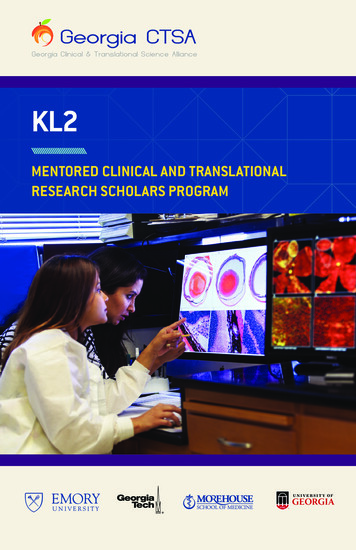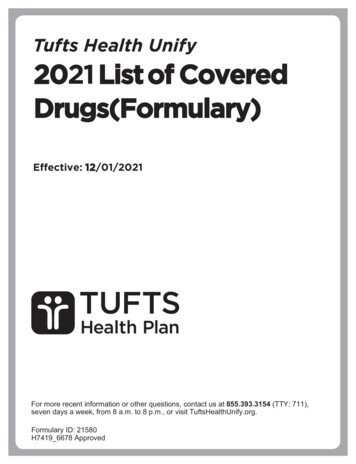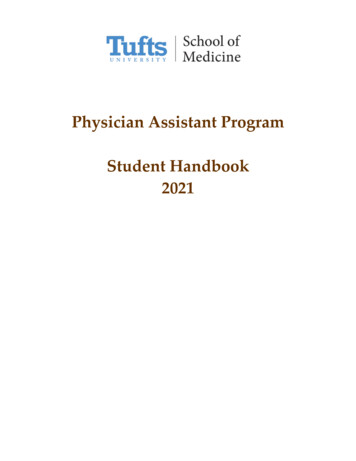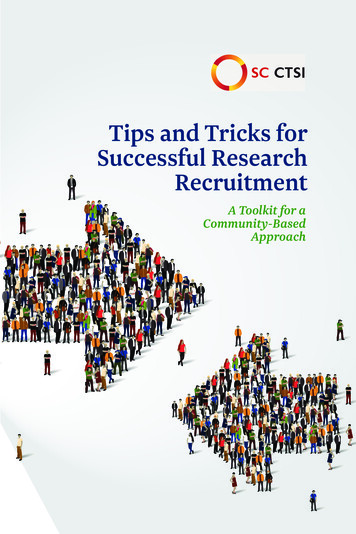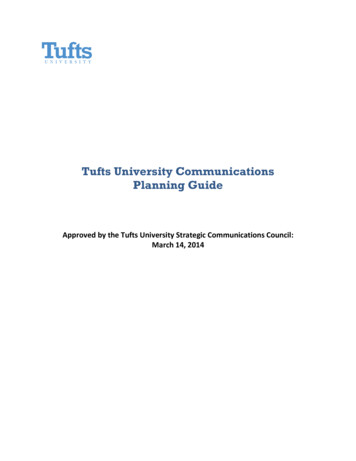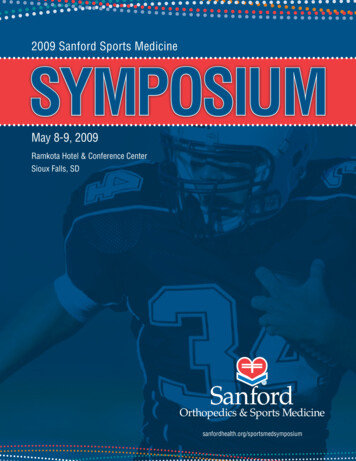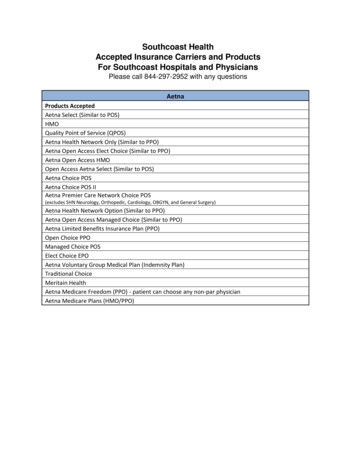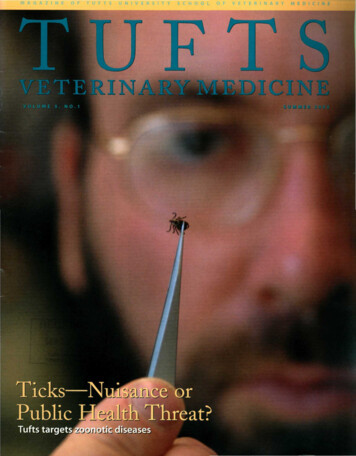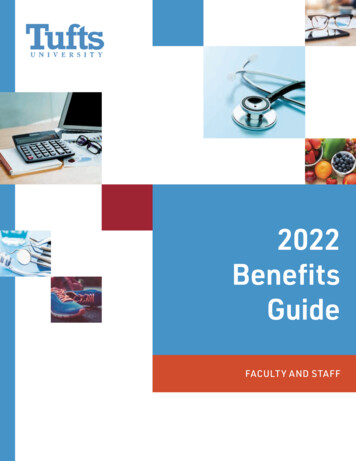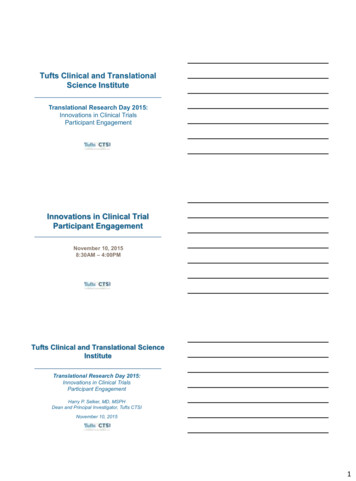
Transcription
Tufts Clinical and TranslationalScience InstituteTranslational Research Day 2015:Innovations in Clinical TrialsParticipant EngagementInnovations in Clinical TrialParticipant EngagementNovember 10, 20158:30AM – 4:00PMTufts Clinical and Translational ScienceInstituteTranslational Research Day 2015:Innovations in Clinical TrialsParticipant EngagementHarry P. Selker, MD, MSPHDean and Principal Investigator, Tufts CTSINovember 10, 20151
Tufts CTSI’s Mission & Purpose Our mission is to stimulate andpromote innovative clinical andtranslational research,with the goal of improvingthe public’s health We serve this objective byfacilitating, improving, andsupporting others’ research, andthrough education and training A research services instituteThe Spectrum of Clinical and TranslationalResearch: The Four Translational StepsT1Bench andanimalresearchT2Clinicaltestingand trialsT3Testing inpracticesettingsT4HealthcaresystemdeliveryPublic healthand healthpolicyClinical & TranslationalScience Awards More than 60 NIH CTSAs (www.ctsaweb.org) areintegrative academic homes for clinical andtranslational science to:– Train, nurture and synergize multi- and interdisciplinary investigators and teams– Accelerate research to catalyze the application ofnew knowledge and techniques to clinical practice– Engage communities in clinical research efforts2
Tufts CTSI Resources and Services Connections to collaborators and research projects Signature Programs: Comparative Effectiveness Research,Research Process Improvement, Stakeholder and CommunityEngagement, One Health Regulatory support Biostatistics, epidemiology, and research design (BERD Center) Informatics Clinical study support (Clinical and Translational Research Center) Pilot Studies Program Training and education– CTS Graduate Program– KL1 Career Development Awards & TL1 Fellowships– Professional DevelopmentRequest CTSI Services at www.tuftsctsi.orgGet Connected: CTSI Happenings Weekly e-newsletter withnews, professionaldevelopment and fundingopportunities, resources,and success stories. Issued every Monday at8AM Sign up on our website orat http://eepurl.com/C4d9X3
http://ilearn.tuftsctsi.org/Live seminars are recorded for our I LEARN site.Seminar videos can be viewed at any time, and are free!Profiles: Researcher NetworkingNIH NCATS Driving Streamlining ofCTSA Consortium Trials Research training standards for all CTSA study sites– Good Clinical Practice– Education in translational research competencies A single IRB (IRBrely) for each multi-site trial Streamlined budgeting and contracting– Accelerated confidential disclosure agreement (ACDA)– Accelerated clinical trial agreement (ACTA)– Accelerated subcontracting4
NCATS Transformation of CTSAConsortium Multicenter Clinical StudiesTufts Clinical & Translational Research Center(CTRC): A Resource for Clinical StudiesSupports investigator-initiated and industry-initiated clinicalresearch involving participants of all ages Services:- Clinical study unit- Nursing- Coordinator- Regulatory “CTRC-without-walls” supports studies in:- Tufts Medical Center inpatient and outpatient sites- Other Tufts CTSI hospitals and clinicsTufts CTSI Clinical Research NetworkCTSI Research Network Hospitals: Baystate Medical Center Lahey Hospital & Medical Center Maine Medical Center New England Baptist Hospital Newton-Wellesley Hospital Tufts Medical Center and FloatingHospital for Children5
Tufts CTSI Clinical Research NetworkGoal: Multi-site Studies of All TypesOh, what about those clinical trialparticipants?Americans and Clinical Research How important is clinical research? Great value58%, Some value 38%, Not much value 4% Have you (or family member) participated in clinicalresearch? Yes 15%, No 85% How likely are you to volunteer for clinicalresearch? Very likely 30%, Somewhat likely 44%,Not likely 20%, Would not 6% Has your doctor ever suggested participating ina clinical study? Yes 6%, No 94%Research!America 20096
Clinical Trial Access via Patient PortalClinical Trial Access via Patient Portal Tufts Medical Center’s patient portal provides onlineaccess to make appointment requests, view lab results,request prescription refills, etc. Tufts CTSI and Tufts Medical Center worked to put a linkon the portal home page to the clinical trials web page This should result in greater visibility for, and patientparticipation in, Tufts Medical Center trials Trialists: Make sure your trials are listed! CompleteClinical Research Recruitment Website form (in packets)and submit to Doug Reichgott in Research AdministrationOh, what about those clinical trialparticipants? Take it to the streets!7
Thank You!WelcomeThe mPower App andUsing Technology Tools forParticipant Engagementin Clinical TrialsKarl Kieburtz, MD, MPHRobert J. Joynt Professor in NeurologyDirector, Clinical & Translational Science InstituteSenior Associate Dean for Clinical ResearchUniversity of Rochester School of Medicine8
Transforming Clinical ResearchThe Return of the House CallKarl Kieburtz MD MPHUniversity of Rochester Medical CenterDirector, Clinical & Translational Science InstituteRobert J Joynt Professor of NeurologySenior Associate Dean, Clinical ResearchGrand RoundsMay 8, 2015DisclosuresResearch GrantsNIH (NINDS), the Michael J. Fox Foundation, TevaConsultingUS FDA, VA, NIH (NINDS), Acorda, Aptiv, Alnylam, AstraZeneca,Biogen-Idec, Biotie, Biovail, Britannia, CHDI, Civitas, Clintrex,Cynapsus, Genzyme, Impax, Intec, Ipsen, Isis, Lilly, Lundbeck,Melior, Neurmedix, Neuroderm, Novartis, Orion, Otsuka,Pharma2b, Phytopharm, Pfizer, Roche, Serina, Stealth Peptides,Synagile, Upsher-Smith, USworldmeds, Vaccinex, Vectura,Voyager, Weston Brain Institute, XenoportHouse calls were standard practice forphysicians in the early 20th centuryBrief history of house calls, 1930-1980Proportion of patient-physician encounters that were in the home40%30%20%10%0%193019501980Factors leading to the decline of the house call Transportation – Increasing availability of cars due to lower cost and improvedroads Technology – Diagnostic and therapeutic technologies (e.g., x-rays, ECGs, labs)moved care from the home to more expensive institutionsSources: Unwin BK, et al. House Calls. Am Fam Physician 2011; 83: 925-38. Kao H, et al. The past, present, and future of house calls. Clin Geriatr Med 2009; 25: 19-34.Photos: Moore J. What Sir Luke Fildes’ 1887 painting The Doctor can teach us about the practice of medicine today. Br J Gen Pract 2008; 58: 210-3; Ann Intern Med2015;162:587-89
Telecommunications and technology arebringing the house call backProportion of American adults with broadband access, 2000 – 2010BroadbandDial-upSource: Pew Research Center. oadband-adoption/The result is the virtual house call Virtual house calls for episodic conditionsSource: Doctor on Demand. http://www.doctorondemand.com/medical that many organizations are now providingVirtual house calls for episodic conditionsSource: Ann Intern Med 2015;162:587-910
Remote care will increasingly become the normOffice vs. virtual visits at Kaiser Permanente Northern California, 2008-2013“I expect that by 2016, with the expanded use of video, the number of virtualvisits—including secure email, telephone, and video encounters—in KPNC willsurpass the number of in-person office visits.” – Robert M. Pearl, MD; Exec.Dir. & CEO – Permanente Medical GroupSource: Pearl R Health Aff 2014;33:251-257Technology will reshape the way we delivercareMayo Clinic Plans for 2020“How can we help patients everywhere? Our board has approved our plan that by2020 we will have meaningful interactionwith 200 million people per year [Ultimately], why wouldn’t we at Mayo sharewhat we know with people everywhereremotely.”Dr. John NoseworthySource: Nisen M. Mayo Clinic has a radical plan to expand its reach across the world. Business Insider. February 13, 2013. Availableat: ure-of-healthcare-2013-2.Outline Access challenge for Parkinson disease Virtual visits for Parkinson disease Smartphone application for objectivelymeasuring symptoms in Parkinson disease11
Outline Access challenge for Parkinson disease Virtual visits for Parkinson disease Smartphone application for objectivelymeasuring symptoms in Parkinson diseaseThe burden of chronic conditions such asParkinson disease is growing globallyDistribution of individuals with Parkinson disease by country from 2005 to2030*2005100% 4.1 million individuals2030100% 8.7 million individualsOthers, 10%Brazil, 4%U.S. 7%Others, 12%Brazil, 4%U.S. 8%China, 57%China, 48%India, 8%India, 8%Europe, 14%Europe, 20%*Among individuals over 50 in the world’s ten most and Western Europe’s five most populous nationsSource: Neurology 2007;68:384-6However, access to neurological care is limitedin the United StatesProportion of Medicare beneficiaries with PD who do not see a neurologistSource: Dorsey ER, George BP, Leff B, Willis AW. The coming crisis: obtaining care for the growing burden of neurodegenerative conditions. Neurology2013; 80:1989-9612
Outline Access challenge for Parkinson disease Virtual visits for Parkinson disease Smartphone application for objectivelymeasuring symptoms in Parkinson diseaseWe are using simple, inexpensive technology toreach patients around the worldNovel application of existing technologyEquipment Internet-enabled device Web cam, microphone Encrypted software In-home care Remote patient monitoring Remote study participationWe completed a randomized, controlled trial ofvirtual house calls for Parkinson disease11 patients receive 320 patients with PD attwo centersin-person visits over 6 monthsRandomized9 patients receive 3 telemedicinevisits over 6 months in homeOutcomes:1. Feasibility2. Clinical outcomes3. Economic valueTelemedicineIn-personSponsors:Source: JAMA Neurol 2013;70:565-7013
Patients in both arms had similar clinicaloutcomesClinical outcomesSource: JAMA Neurol 2013;70:565-70Virtual visits flip the care paradigmPatient time spent on in-person versus telemedicine visitsSource: JAMA Neurology 2013;70:565-70.Virtual visits offer patients care, convenience,and comfortFeedback from patients and familiesCareConvenienceComfort “We had a good family crying moment after the appointment from justpure joy of finally having the opportunity for him to see a (Parkinsondisease) specialist” “The (Parkinson disease) literacy was amazing” “It’s great not having to drive the 2 hours having the added expense ofmy wife missing an entire day of work, [and] saving on gas for the car, tolls,[and] parking” “I could have access to a movement specialist, which I currently don’twhere I live” “I liked the interaction being personal despite the 3000 mile distance.itfelt somehow protected by the veil of technology, which enabled theexchange to be more honest” “I am more relaxed in my home setting”Source: Neurol Clin Pract. 2014;4(2):146-152.14
We have completed enrollment in a national randomizedcontrolled trial of telemedicine for Parkinson diseaseIn collaboration with:Connect.Parkinson.orgInterest in the study has been very highPhysicians are generally satisfied but haveconcerns about the quality of the connectionInitial clinician feedbackN 87 responses605040Very satisfiedSatisfied30NeutralUnsatisfied20Very cted physician feedback “Visit interaction was great, but it was very difficult to determine actual ratings for rapidlyalternating movements.” “Video quality, particularly for rating Unified Parkinson’s Disease Rating Scale is frustrating.” “I think it is fine for the interview part, and maybe for clinical follow-ups.”Source: Connect.Parkinson Study15
Patients are very satisfied with the telemedicinevisitsInitial patient feedbackN 85 responses807060Very satisfied50Satisfied40Neutral30Unsatisfied20Very allSelected patient feedback “I learned more in one visit than all the information provided by other physicians over a period ofyears!!!” “I felt it was a great doctor’s visit. Better than many I’ve had face to face.” “It was so good to not have to ride 45 minutes in a handicapped van each way to see a (movementdisorder specialist).” “On a cold rainy day it was so nice not to have to worry about getting a ride and getting from the carto the office. I could concentrate on what I wanted to ask and the info the doctor provided.”Source: Connect.Parkinson studyWith 23andMe, we assessed the phenotype ofindividuals who know their genetic informationStudy’s aims1. To assess feasibility of recruiting participants for a remote research study2. Assess ability to collect data remotely3. Assess validity of self-reported data from individuals with Parkinson diseaseMethodsOne-time remote standardized assessment of individuals with self-reportedParkinson disease who live in the U.S., have high speed internet access, and mayhave at least one genetic risk variant for Parkinson diseaseOutcome measures1. Motor and non-motor characterization of participants2. Validation of self-completed 23andMe Parkinson’s disease baseline surveySponsorWe conducted remote assessments with 50participants in 23 states in 3 monthsResults All study participants withself-reported PD werejudged by neurologists tohave PD (k 1.00) Also had high level ofagreement for age of onset(k 0.97) and presence offamily history (k 0.85) 95% of participantsindicated interest in futurevirtual research visits This study sets the stagefor larger scale studiestargeting genetic subpopulationsMap of participantsSource: Digital Health available at: 6
We performed a similar study with Fox Trial Finder andconnected remotely to over 160 participants in 39 statesMap of participantsThis study provided some valuable insightsVirtual research visitsMethods Fox Trial Finder participants providedconsent by phone, completed baselinesurveys, downloaded video conferencingsoftware, and received a web camera. After a test connection, participantsunderwent a remotely assessed cognitionand had a virtual research visit to:(1) Review their history(2) Perform MDS-UPDRS (modified toexclude assessments of rigidity andbalance).(3) Confirm whether PD was the mostlikely diagnosis,(4) Solicit feedback on their experienceResults 81.4% individuals from 39 statescompleted the visits On average, participants were:(1) 61.6 years old(2) Had Parkinson disease for 8.0 years(3) Scored 26.5 on the Montreal CognitiveAssessment(4) Had modified UPDRS motor score of22.8.(5) Parkinson disease was most likelydiagnosis in 97.0% of cases. Overall satisfaction with the visits was79% (satisfied or very satisfied) amongneurologists and 93% among participants.Transforming face-to-face clinical research Individuals can accurately self-identify illnesses,sometimes using direct to consumer testing Individuals endorse ‘research from home’ Researchers endorse remote evaluations, butfeel some constraints with technology Researchers in one location can access andevaluate potential participants in a national andperhaps global distribution The model of an academic clinical research sitewith a local reach is actively being ‘disrupted’17
New tools and technologies can fosterdisruption in clinical trials21st century tools and methodologiesSource: JAMA Neurol. doi:10.1001/jamaneurol.2014.4524Outline Access challenge for Parkinson disease Virtual visits for Parkinson disease Smartphone application for objectivelymeasuring symptoms in Parkinson diseaseMovement disorders have externalmanifestations that smartphones can assessFigure 1: Picture of Android smartphone andsoftware application.Figure 2: Procedure for collecting voicerecordings, finger tapping, and passivesensor data from gait and postural sway testSource: Parkinsonism & Related Disorders, .18
1.4a) Gait testDetrended fluctuation analysisParticipant with Parkinson deseaseControl participant1.21Smartphones can distinguish those with PD fromthose withoutGait and posture tests in Parkinson disease0.8-2test1.4Participant with Parkinson deseaseControl participantDetrended fluctuation analysis02468Teager-Kaiser energy operator x 10 -4Posturalswayb)Postural swaytest1.210.8Detrended fluctuation analysis1.4Gaittesta)Gait test1.210.80.6-202468Teager-Kaiser energy operator x 10 -400.51Teager-Kaiser energy operator1.5b) Postural sway testDetrended fluctuation analysis1.41.2Source: Parkinsonism and Related Disorders 2015 (epub ahead of print)10.80.600.51Teager-Kaiser energy operator1.5We have recently launched a 2000 personsmartphone study in 1/Smartphones allow for global participationanytime anywhereGeographical representation of study participants (N 653)19
Most participants were recently diagnosedIn March Apple announced the release ofsmartphone applications for medical researchmPower smartphone application for Parkinson disease59mPower includes surveys, structured tests ofcognition, speech, speeded taps, speed and gait20
This technology is currently being used in clinical trialsto capture objective measures of Parkinson disease61We plan to have new generations of mPower withgreater functionalitymPower 1.0Android Global reach PassivemonitoringPilot Differentiatebetween controlsand PD Participantempowermentand feedbackIn two months,over 13,000individuals haveenrolled in thestudy of whom10% haveParkinson diseaseQuestions?21
Thank You!Participant Engagement:Why Participate in Research?Participation in Clinical Research:Motivations and PerspectivesJulia Farides-Mitchell, MAProject ManagerThe Center for Information & Study onClinical Research Participation (CISCRP)22
Participation in Clinical ResearchMotivations and PerspectivesJulia Farides-Mitchell, MAProject ManagerPatient Engagement and Communication ProgramsThe Center for Information & Study on Clinical ResearchParticipation (CISCRP)November 2015Learning Objectives Explain why Patients participate inclinical research Describe how Patients feel abouttheir participation in ClinicalResearchJ. Farides-MitchellNovember 2015Key Topics to Discuss Why Patients participate in clinicalresearch How Patients Feel about theirparticipation in Clinical Research Assessment of where clinical trialsmay be falling short in patientengagementJ. Farides-MitchellNovember 201523
Types of Patients Involvedin Clinical Research Patients can be separated into a fewdifferent groups General Public Lay Public not actively looking to participatein clinical research Perspective Patient Lay Public actively looking for clinical trials toparticipate in Healthy Patients Patients seeking condition-specific trials Participating Patients Lay Public who have participated, and mayparticipate again, in clinical researchJ. Farides-MitchellNovember 2015Why Patients Participate General Public Perspective Patient Healthy Patients Altruism Monetary Gain Patients seeking condition-specific trials Varied treatment options Suggestion from their doctor/friend/family Altruism Monetary Gain/Free care Participating Patients Repeat participants Positive experience in previous trialsJ. Farides-MitchellNovember 2015Patients and TheirParticipation Patients Understand the Importance of theirparticipation, but It often lacks personal relevance They feel as though they are gambling with their health i.e. they are “guinea pigs” They question the quality of care they will receive They lack knowledge about clinical research Clinical research has no “public face” Clinical research is a very large unknown to manypatients, and has many misconceptions in the generalpublic They do not feel engaged in the process Clinical research may feel alienating Clinical research often lacks critical follow-up to informpatients about results of their trialsJ. Farides-MitchellNovember 201524
Improving PatientEngagement Before the trial Putting a face to clinical research Education about clinical research provides patients with a sense ofpersonal relevance and informs patients at the same time Engaging previous participants to talk to prospective participants Patient Advisory Boards Engage patients before the protocol is finalized to provide feedbackon ease of participation, patient-centered accommodations, andpatient experience with their condition Contributes to increased relevance During the trial Addition of more patient-centered initiatives andaccommodations After the Trial Providing patients the results of their trial brings closure to theirparticipation Increases relevance of their participationJ. Farides-MitchellNovember 2015Questions?Thank You!25
Challenges and Rewards of EngagingPet Owners in Clinical Trials inVeterinary MedicineAndrew Hoffman, DVM, DVSc, Diplomate, ACVIMProfessor, Large Animal MedicineDirector, Regenerative Medicine LaboratoryCummings School of Veterinary MedicineTufts UniversityLearning Objectives Discuss the major objectives of clinical trials inveterinary patients Identify the major issues impending participantengagement Describe ethical incentives and solutions that willhelp to increase participant engagement Explain major challenges that may be faced inthe futureDemographics in Veterinary Medicine(www.avma.org) Dogs (70M), Cats (74M), Horses (4.8M), Birds (8M) Veterinarians: 102,583 (AVMA 2014 data) University Teaching Hospitals: 30 (2014) e.g. Caseload @ Cummings School – Tufts 40,000/yr Specialists: 11,761 Cardiology, Dermatology, Ophthalmology, ECC,Neurology, Nutrition, Oncology, Pathology, InternalMedicine, Virology, Bacteriology/Microbiology26
Companion Animal Diseases(And Models of Human Conditions)CardiacMyxomatous mitral valve disease (Mitral valve prolapse)Arrythmogenic right ventricular cardiomyopathyDilated cardiomyopathyHypertrophic cardiomyopathyNeurologicIntervertebral disc herniationEpilepsyCanine cognitive dysfunction syndrome (Alzheimer’sDisease)Degenerative myelopathy (ALS)Gastrointestinal Inflammatory bowel diseasePeri-anal fistulas (fistulizing Crohn’s disease)Dermatologic Atopic dermatitisPemphigus foliaceousMusculoskeletal OsteoarthritisHip dysplasiaOphthalmologic Auto-immune uveitis, GlaucomaKeratoconjunctivitis siccaGlioblastomaKeratoconjunctivitis sicca flammatorybowel diseaseOsteoarthritisTendinopathiesKol, Arzi, et al. Science 2015Dual Benefit of Many CompanionAnimal StudiesKol, Arzi, et al. Science 2015Past examples (selected):Keratoconjunctivitis Sicca (KCS):RestasisLifitegrastNon-Hodgkins’s Lymphoma:IbrutinibOsteosarcomaLimb-sparing surgery (ped, adult)Mandibular reconstructionrhBNP2Companion Animal Study ParadigmCompanionanimaldiseasemodel(CADM) Innovative strategy Pre-CADM safetytesting PoC Long-term safety Clinical trial simulation Optimization Personalization ReproducibilityHumanclinicalstudies27
egenerative-medicine-stem-cell-trials/ Wharton’s Jelly mesenchymal stem cell transplantation Mitral valve dysplasia with congestive heart failure Arrhythmogenic right ventricular cardiomyopathy Atopic dermatitis Inflammatory bowel disease Perianal fistulas/fistulizing Crohn’s Disease Immune complex glomerulonephritis Intervertebral disc herniation exRNA biomarkers Plasma biomarkers post-CPR Plasma and urinary biomarkers for mitral valve disease Plasma biomarkers for ARVCParticipantsOwners companion animalsCSRC or IACUC Referring veterinarian informed consent incentivesReferral center Principal investigator/Clinician-scientist House officers (specialists, trainees,internal referrals, specialty techs) Clinical trial staff (technician,supervisor, sample lab tech) Animal Health Technicians (nurses) Research accounting Diagnostic labChallengesOwners companion animalsCSRC or IACUC Referring veterinarian informed consent incentivesReferral center Principal investigator/Clinician-scientist House officers (specialists, trainees,internal referrals, specialty techs) Clinical trial staff (technician,supervisor, sample lab tech) Animal Health Technicians (nurses) Research accounting Diagnostic lab28
Deterrents for Owners Painstaking protocol – loss of work or vacation time Safety risks to animal Have to change food (or any behavior) Trials with no incentives Stress of procedures (e.g. extra blood draws) Owners during stressful time Placebo controlled studies Insufficient incentives to offset of SOC Stress of leaving animal behind or being without animal Fear of research (depends on relationship with doctors) Insufficient in reserve for complications Confusing consent forms (unusual) Stem cells (general fear) Warnings on consent forms (depends on explanation) Xeno productsFinancial or Equivalent IncentivesOwners companion animalsCSRC or IACUCReferring veterinarian approvalPhysician(MD)CollaboratorsBasicScienceLabs informed consent incentivesReferral center Principal investigator/Clinician-scientist House officers (specialists, trainees,internal referrals, specialty techs) Clinical trial staff (technician,supervisor, sample lab tech) Animal Health Technicians (nurses) Research accounting Diagnostic labCurrent Incentives to Ownersn 72/75 open trials at Tufts Veterinary Medical Center Screening and/or repeated lab work Imaging (CT, MR, Ultrasound, Fluoro) Offset surgical costs (disc herniation) ECG monitoring (home) Biopsies Recheck exams 300 toward purchase of cyclosporine 25% bill up to 1500 500 (to be spent on patient within 1 year) 150 gift card (if study completed) 1250 toward radiation Parking fee reimbursement29
Deterrents for RDVM & Clinicians Do not know about clinical trials (n 75) Insufficient time to participate (especially after hours) PI not driving clinical trial Other Teaching burdenInadequate staffing to triage eligible casesTime-consuming EMR that does not serve clinical trialsWork does not benefit promotionPerceived need more investments in clinical trialsOveremphasis on bottom line by hospital administrationClinicians- Actual Support Digital white board in middle of hospital Study protocols icon/list on every computer Bi-Monthly newsletters (clients, RDVM, and H-Officers) Visits to RDVM hospitals Research seminars for House Officers with food Other Promotion incentives for collaboration Student/Intern/resident orientation Internal RFAs supporting research Laboratory support Clinical trial technicians (2 FTE) and super (0.5 FTE) Clinical trial website Website – inquire by email – daily checkedFuture Directions Apps for identifying clinical trials EMR working for clinical trials (flagging) Staff to identify eligible cases PI more aggressive information campaign Incentivize house officers equitably (all trials) Focus on ER Better predictions of caseload More stringent criteria for trial failure Multi-center approach30
Regenerative Medicine LaboratoryVicky Yang, Research Assistant Professor, Assistant DirectorAlisha Gruntman, Assistant ProfessorKristen Thane, Post-Doctoral ScholarSarah Crain, PhD CandidateAiriel Davis, Research AssistantDawn Meola, Research Assistant (Clinical Trial Supervisor)Christine Juhr, Large Animal TechnicianDiane Welsh, Clinical Trial TechnicianKerry Loughran, Veterinary Student Researcherhttp://vetsites.tufts.edu/rml/Tufts FacultySuzanne Cunningham and John Rush (Cardio), Dominik Faissler (Neuro), LluisFerrer and Andrea Lam (Derm), Mary Labato and Cyntheia Leveille-Webster(Internal Medicine), Liz Rozanski (ER), Nick Robinson DVM PhD (Pathology)CollaboratorsSupportSaumya Das, MD, PhD (Beth Israel Hospital)Shipley FoundationQuestions?Thank You!31
Challenges in Consenting PregnantWomen, Children and NeonatesJonathan Davis, MDVice-Chair of Pediatrics for Academic AffairsChief of Newborn MedicineThe Floating Hospital for Children at Tufts Medical CenterProfessor of PediatricsTufts University School of MedicineDirector of Regulatory AffairsTufts CTSIDisclosures I have no conflicts of interest to disclose I am funded by NIH and FDA to study new andexisting agents to improve neonatal outcome I Chair the Neonatal Advisory Committee in theOffice of the Commissioner at the FDA. Mypresentation reflects my own opinions and does notnecessarily represent the opinions of the FDA I am a Director of the International NeonatalConsortium through FDA/EMA/Critical Path InstituteLearning Objectives Identify important issues when conductingresearch on vulnerable populations Explain the challenges when consenting pregnantwomen or their infants Discuss the unique challenges of conductingresearch on premature infants (e.g. bloodsampling, outcomes)32
Registered Trials in ClinicalTrials.gov*60,00055,515Number of Trials50,00040,00030,00020,00010,0005,03500-17 y 18 y*Children represent 20% of the population; only 300 registered studies pertain to neonatesWhy has Drug Development forPregnant Women, Children andNeonates Been so Difficult? Small markets Rare diseases High risk - significant liability Appropriate animal models? Difficulty with study design/outcome measures May need to wait to determine outcome Hard to establish safety – prenatal exposure, postnatalexposure, environmental influences Hard to establish efficacyEthical Considerations Human subject protections at 21 CFR Part 50 Additional safeguards found at Subpart D – is thereprospect of direct benefit? Does the study represent a minor increase overminimal risk? Should we consent pregnant mothers prior tolabor, in active labor, or after delivery when weknow the neonate meets criteria? How about
University of Rochester Medical Center Director, Clinical & Translational Science Institute Robert J Joynt Professor of Neurology Senior Associate Dean, Clinical Research Disclosures Research Grants NIH (NINDS), the Michael J. Fox Foundation, Teva Consulting US FDA, VA, NIH (NINDS), Acorda, Aptiv, Alnylam, AstraZeneca,
